Overview
- Brief Narrative
- Handmade, papier-mâché hand puppet of a pale faced man, created by Albert Guenther Hess in New York as a way to cope with his experiences as a Holocaust survivor and soldier in World War II. Albert Guenther Hess’s family owned a successful chemical factory in the town of Pirna, Germany. Albert studied law, but also had a passion for music and film. In 1933, Albert was fired from his legal position in the Ministry of Justice because he was Jewish. He then took a position as a legal advisor for his family’s business. In 1937, he began working in Belgium as a representative for his family’s company. On May 10, 1940, Germany invaded Belgium and Albert, a German national, was arrested by the Belgian police and detained in Saint Cyprien. He was then sent to Gurs, and Les Milles detention camps in France by the Germans. In February 1941, Albert was released, and traveled to Marseilles. He immigrated to the United States and arrived in New York in March 1941. In 1943, Albert was drafted into the U.S. Army. He served as a translator and investigator for the military intelligence unit of the 44th Infantry Division. His unit assisted in the liberation of Dachau where Albert photographed and documented camp atrocities. Afterwards, he acted as a German translator and interviewer for Nazi prisoners, including Hermann Göring. Albert returned to the United States in 1945 and later served as a secretary for the United Nations.
- Date
-
creation:
1956-1957
- Geography
-
creation:
Queens (New York, N.Y.)
- Credit Line
- United States Holocaust Memorial Museum Collection, Gift of Marie Brandes Hammerling
- Contributor
-
Subject:
Albert G. Hess
Artist: Albert G. Hess
- Biography
-
Albert Günther Hess (1909-1993) was born in Pirna, Germany, to Gustav (1862-1923) and Hermione (Hermine) Bauer Hess (1874-1955). He had two siblings, a brother, Manfred (1898-1980) and a sister, Isabella Ilse (1897-1985). The Hess family was a prominent Jewish family in Pirna. Gustav was a chemist and founded the Gustav Hess Chemical Factory in 1895. The factory specialized in the production of black enamel and oil varnishes used in the production of telephones, cameras, and the German Iron Cross medal. The Hess family was not particularly religious and were well assimilated into the community. In 1923, Gustav died suddenly and Albert's older brother Manfred took over the chemical factory. Albert's sister, Isabella married Alfred Rosenstern (1888-1960, later Roston). Music and film were two of Albert’s passions to which he devoted much of his time. He studied the piano for ten years, organ for one year, and could play the organ, flute, oboe, clarinet, and recorder. Albert wrote and published several papers, studies, and books on music. In the 1930s, Albert also began making travel and family films on 9.5mm stock.
In 1928, Albert graduated from the König-Georg-Gymnasium in Dresden. He then studied law in Hamburg, Bonn, Berlin, Leipzig and London. In 1933, Adolf Hitler was appointed chancellor of Germany. The German authorities passed many anti-Semitic laws that isolated and restricted the everyday lives of the Jewish community. Albert worked for the Ministry of Justice in Dresden until July 1933, when he was fired for being Jewish. In 1934, Albert earned his doctorate from the University of Leipzig. He then went to work as a legal advisor for his family’s business. In 1935, in Brussels, Belgium, Albert married Anni Ilse Zobel (b. 1914) from Dresden. In December 1937, Albert immigrated to Belgium and began work as the Gustav Hess Chemical Factory’s representative to France, Belgium, and the Netherlands. He held this position until the end of 1939 when the company was forcibly taken over by ethnic Germans, a process called Aryanization. Albert's mother, brother, sister, and their families were able to escape to England in 1939. Manfred and his family remained in England while Hermine, Isabella, and her husband immigrated to the United States on the SS Pennland, arriving on December 23, 1939.
On September 1, 1939, Germany invaded Poland, and a few days later, France and England declared war on Germany, initiating World War II. On May 10, 1940, Germany invaded Belgium, and Albert, a German national, was arrested the same day by Belgian police. He was sent to the overcrowded and unsanitary Saint Cyprien internment camp in southern France. On May 28, Belgium surrendered to Germany, and the German Army continued on to defeat and occupy part of France. In October, Albert was deported to the Gurs detention camp in southwestern France. The camp was overcrowded and lacked food, water and clothing for the prisoners. In January 1941, Albert was transported to the Les Milles internment camp where he was finally released in February. Albert then travelled to Marseilles where he reunited with his wife, Anni. The couple left for Martinique and then travelled to the US Virgin Islands on the ship Fort De France, and continued on to Puerto Rico and then to the United States aboard the San Jacinto arriving in New York on March 27, 1941.
In the U.S., Albert worked in a paint factory and taught music until 1943 when he was drafted into the army. Albert entered the U.S. Army on August 19 as a private with serial number 31340564. He served as a translator and investigator for the military intelligence unit of the 44th Infantry Division. The 44th landed in Cherbourg, France on September 15, 1944 and entered combat on October 18 in southern Germany. Albert and his men were at Berchtesgaden, the location of Hitler’s personal residence, Berghof, where they invaded the Nazi wine cellar. Albert assisted in the liberation of Dachau, where he photographed and documented camp atrocities. He acted as a German translator and interviewer for Nazi prisoners, including Hermann Göring. Albert was honorably discharged on December 4, 1945, as a Staff Sergeant.
Upon his return from the war Albert divorced his wife and married Gisela Oppens (1912-1996) in September 1946. Gisela, a fellow German Holocaust survivor, had entered university in Prague, Czechoslovakia in 1934, but was later expelled for being Jewish. She converted to Catholicism, to deter the anti-Semitism, but to no effect. In 1939 Gisela escaped to Portugal where she worked as a nanny until she was able to obtain passage to the United States on the Amarante on April 19, 1943. Albert received a Ph.D. from Cornell University and earned degrees in musicology and art history. He taught music at several universities, and served as a secretary at the United Nations. Albert and Gisela divorced, and Albert married Julia Kao (1916-2003) in 1960.
Physical Details
- Classification
-
Art
- Category
-
Sculpture
- Object Type
-
Puppets (lcsh)
- Genre/Form
- Hand puppets.
- Physical Description
- Handmade hand puppet with a papier-mâché head and a rectangular gray chambray cloth body. The head is turned to the left and painted white with short black hair and black, pronounced eyebrows, narrow black, slanted eyes, and a white nose. The rounded head is wide at the top and tapers down to a thin neck. The papier-mâché neck is wrapped around a cylindrical cardboard tube. The body is made from two pieces of cloth that are sewn together with light blue thread in plain side seams with a hemmed lower opening for a hand. The fabric at the top of the body is open and folded inward. The head sits in the opening and the neck is attached to the fabric with a rubber band on the interior. The cloth protrudes out just below the head to form two short arms. The head’s surface is very rough and uneven. There is a small white stain near the puppet’s right arm.
- Dimensions
- overall: Height: 14.625 inches (37.148 cm) | Width: 7.125 inches (18.097 cm) | Depth: 2.875 inches (7.302 cm)
- Materials
- overall : papier mâché, paint, cloth, thread, rubber, cardboard
Rights & Restrictions
- Conditions on Access
- No restrictions on access
- Conditions on Use
- No restrictions on use
Keywords & Subjects
- Topical Term
- Aryanization. Holocaust, Jewish (1939-1945)--Austria--Vienna--Personal narratives. Jews--Persecution--Germany--Biography. United States--Emigration and immigration--Biography. World War, 1939-1945--Refugees--Great Britain. Jewish refugees Germany. German American soldiers--United States. Post-traumatic stress disorder. Art therapy.
- Personal Name
- Göring, Hermann, 1893-1946.
Administrative Notes
- Legal Status
- Permanent Collection
- Provenance
- The puppet was donated to the United States Holocaust Memorial Museum in 2017 by Marie Hammerling, the daughter of Albert Guenther Hess.
- Record last modified:
- 2024-02-06 10:20:13
- This page:
- https://collections.ushmm.org/search/catalog/irn561938
Download & Licensing
In-Person Research
- By Appointment
- Request 21 Days in Advance of Visit
- Plan a Research Visit
- Request to See This Object
Contact Us
Also in Albert Günther Hess collection
The collection consists of handmade puppets, two photo albums and loose photographs relating to the experiences of Albert Günther Hess and his family before and during the Holocaust in Germany, Belgium, and France and the experiences of Albert in the United States and after his service in World War II. Some of these materials may be combined into a single collection in the future.
Date: before 1939-1957
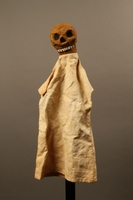
Skull faced hand puppet created by a German Jewish Holocaust survivor and World War II veteran
Object
Handmade, papier-mâché hand puppet with a skull head, created by Albert Guenther Hess in New York as a way to cope with his experiences as a Holocaust survivor and soldier in World War II. Albert Guenther Hess’s family owned a successful chemical factory in the town of Pirna, Germany. Albert studied law, but also had a passion for music and film. In 1933, Albert was fired from his legal position in the Ministry of Justice because he was Jewish. He then took a position as a legal advisor for his family’s business. In 1937, he began working in Belgium as a representative for his family’s company. On May 10, 1940, Germany invaded Belgium and Albert, a German national, was arrested by the Belgian police and detained in Saint Cyprien. He was then sent to Gurs, and Les Milles detention camps in France by the Germans. In February 1941, Albert was released, and traveled to Marseilles. He immigrated to the United States and arrived in New York in March 1941. In 1943, Albert was drafted into the U.S. Army. He served as a translator and investigator for the military intelligence unit of the 44th Infantry Division. His unit assisted in the liberation of Dachau where Albert photographed and documented camp atrocities. Afterwards, he acted as a German translator and interviewer for Nazi prisoners, including Hermann Göring. Albert returned to the United States in 1945 and later served as a secretary for the United Nations.
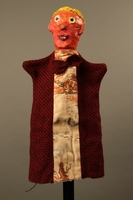
Blond haired hand puppet created by a German Jewish Holocaust survivor and World War II veteran
Object
Handmade, papier-mâché hand puppet of a blond haired man, created by Albert Guenther Hess in New York as a way to cope with his experiences as a Holocaust survivor and soldier in World War II. Albert Guenther Hess’s family owned a successful chemical factory in the town of Pirna, Germany. Albert studied law, but also had a passion for music and film. In 1933, Albert was fired from his legal position in the Ministry of Justice because he was Jewish. He then took a position as a legal advisor for his family’s business. In 1937, he began working in Belgium as a representative for his family’s company. On May 10, 1940, Germany invaded Belgium and Albert, a German national, was arrested by the Belgian police and detained in Saint Cyprien. He was then sent to Gurs, and Les Milles detention camps in France by the Germans. In February 1941, Albert was released, and traveled to Marseilles. He immigrated to the United States and arrived in New York in March 1941. In 1943, Albert was drafted into the U.S. Army. He served as a translator and investigator for the military intelligence unit of the 44th Infantry Division. His unit assisted in the liberation of Dachau where Albert photographed and documented camp atrocities. Afterwards, he acted as a German translator and interviewer for Nazi prisoners, including Hermann Göring. Albert returned to the United States in 1945 and later served as a secretary for the United Nations.
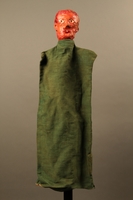
Red haired hand puppet created by a German Jewish Holocaust survivor and World War II veteran
Object
Handmade, papier-mâché hand puppet of a red faced man created by Albert Guenther Hess in New York as a way to cope with his experiences as a Holocaust survivor and soldier in World War II. Albert Guenther Hess’s family owned a successful chemical factory in the town of Pirna, Germany. Albert studied law, but also had a passion for music and film. In 1933, Albert was fired from his legal position in the Ministry of Justice because he was Jewish. He then took a position as a legal advisor for his family’s business. In 1937, he began working in Belgium as a representative for his family’s company. On May 10, 1940, Germany invaded Belgium and Albert, a German national, was arrested by the Belgian police and detained in Saint Cyprien. He was then sent to Gurs, and Les Milles detention camps in France by the Germans. In February 1941, Albert was released, and traveled to Marseilles. He immigrated to the United States and arrived in New York in March 1941. In 1943, Albert was drafted into the U.S. Army. He served as a translator and investigator for the military intelligence unit of the 44th Infantry Division. His unit assisted in the liberation of Dachau where Albert photographed and documented camp atrocities. Afterwards, he acted as a German translator and interviewer for Nazi prisoners, including Hermann Göring. Albert returned to the United States in 1945 and later served as a secretary for the United Nations.
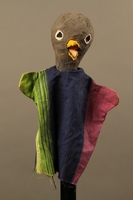
Bird head hand puppet created by a German Jewish Holocaust survivor and World War II veteran
Object
Handmade, papier-mâché hand puppet of a bird created by Albert Guenther Hess in New York as a way to cope with his experiences as a Holocaust survivor and soldier in World War II. Albert Guenther Hess’s family owned a successful chemical factory in the town of Pirna, Germany. Albert studied law, but also had a passion for music and film. In 1933, Albert was fired from his legal position in the Ministry of Justice because he was Jewish. He then took a position as a legal advisor for his family’s business. In 1937, he began working in Belgium as a representative for his family’s company. On May 10, 1940, Germany invaded Belgium and Albert, a German national, was arrested by the Belgian police and detained in Saint Cyprien. He was then sent to Gurs, and Les Milles detention camps in France by the Germans. In February 1941, Albert was released, and traveled to Marseilles. He immigrated to the United States and arrived in New York in March 1941. In 1943, Albert was drafted into the U.S. Army. He served as a translator and investigator for the military intelligence unit of the 44th Infantry Division. His unit assisted in the liberation of Dachau where Albert photographed and documented camp atrocities. Afterwards, he acted as a German translator and interviewer for Nazi prisoners, including Hermann Göring. Albert returned to the United States in 1945 and later served as a secretary for the United Nations.
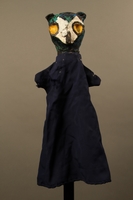
Owl head hand puppet made by a German Jewish Holocaust survivor and World War II veteran
Object
Handmade, papier-mâché hand puppet of an owl created by Albert Guenther Hess in New York as a way to cope with his experiences as a Holocaust survivor and soldier in World War II. Albert Guenther Hess’s family owned a successful chemical factory in the town of Pirna, Germany. Albert studied law, but also had a passion for music and film. In 1933, Albert was fired from his legal position in the Ministry of Justice because he was Jewish. He then took a position as a legal advisor for his family’s business. In 1937, he began working in Belgium as a representative for his family’s company. On May 10, 1940, Germany invaded Belgium and Albert, a German national, was arrested by the Belgian police and detained in Saint Cyprien. He was then sent to Gurs, and Les Milles detention camps in France by the Germans. In February 1941, Albert was released, and traveled to Marseilles. He immigrated to the United States and arrived in New York in March 1941. In 1943, Albert was drafted into the U.S. Army. He served as a translator and investigator for the military intelligence unit of the 44th Infantry Division. His unit assisted in the liberation of Dachau where Albert photographed and documented camp atrocities. Afterwards, he acted as a German translator and interviewer for Nazi prisoners, including Hermann Göring. Albert returned to the United States in 1945 and later served as a secretary for the United Nations.
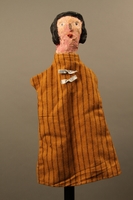
Hand puppet of a woman created by a German Jewish Holocaust survivor and World War II veteran
Object
Handmade, papier-mâché hand puppet of a dark haired woman created by Albert Guenther Hess in New York as a way to cope with his experiences as a Holocaust survivor and soldier in World War II. Albert Guenther Hess’s family owned a successful chemical factory in the town of Pirna, Germany. Albert studied law, but also had a passion for music and film. In 1933, Albert was fired from his legal position in the Ministry of Justice because he was Jewish. He then took a position as a legal advisor for his family’s business. In 1937, he began working in Belgium as a representative for his family’s company. On May 10, 1940, Germany invaded Belgium and Albert, a German national, was arrested by the Belgian police and detained in Saint Cyprien. He was then sent to Gurs, and Les Milles detention camps in France by the Germans. In February 1941, Albert was released, and traveled to Marseilles. He immigrated to the United States and arrived in New York in March 1941. In 1943, Albert was drafted into the U.S. Army. He served as a translator and investigator for the military intelligence unit of the 44th Infantry Division. His unit assisted in the liberation of Dachau where Albert photographed and documented camp atrocities. Afterwards, he acted as a German translator and interviewer for Nazi prisoners, including Hermann Göring. Albert returned to the United States in 1945 and later served as a secretary for the United Nations.
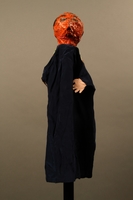
Orange and blue hand puppet created by a German Jewish Holocaust survivor and World War II Veteran
Object
Handmade, papier-mâché hand puppet with hands created by Albert Guenther Hess in New York as a way to cope with his experiences as a Holocaust survivor and soldier in World War II. Albert Guenther Hess’s family owned a successful chemical factory in the town of Pirna, Germany. Albert studied law, but also had a passion for music and film. In 1933, Albert was fired from his legal position in the Ministry of Justice because he was Jewish. He then took a position as a legal advisor for his family’s business. In 1937, he began working in Belgium as a representative for his family’s company. On May 10, 1940, Germany invaded Belgium and Albert, a German national, was arrested by the Belgian police and detained in Saint Cyprien. He was then sent to Gurs, and Les Milles detention camps in France by the Germans. In February 1941, Albert was released, and traveled to Marseilles. He immigrated to the United States and arrived in New York in March 1941. In 1943, Albert was drafted into the U.S. Army. He served as a translator and investigator for the military intelligence unit of the 44th Infantry Division. His unit assisted in the liberation of Dachau where Albert photographed and documented camp atrocities. Afterwards, he acted as a German translator and interviewer for Nazi prisoners, including Hermann Göring. Albert returned to the United States in 1945 and later served as a secretary for the United Nations.
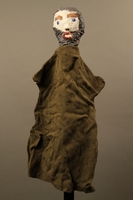
Bearded man hand puppet created by a German Jewish Holocaust survivor and World War II veteran
Object
Handmade, papier-mâché hand puppet of a bearded man created by Albert Guenther Hess in New York as a way to cope with his experiences as a Holocaust survivor and soldier in World War II. Albert Guenther Hess’s family owned a successful chemical factory in the town of Pirna, Germany. Albert studied law, but also had a passion for music and film. In 1933, Albert was fired from his legal position in the Ministry of Justice because he was Jewish. He then took a position as a legal advisor for his family’s business. In 1937, he began working in Belgium as a representative for his family’s company. On May 10, 1940, Germany invaded Belgium and Albert, a German national, was arrested by the Belgian police and detained in Saint Cyprien. He was then sent to Gurs, and Les Milles detention camps in France by the Germans. In February 1941, Albert was released, and traveled to Marseilles. He immigrated to the United States and arrived in New York in March 1941. In 1943, Albert was drafted into the U.S. Army. He served as a translator and investigator for the military intelligence unit of the 44th Infantry Division. His unit assisted in the liberation of Dachau where Albert photographed and documented camp atrocities. Afterwards, he acted as a German translator and interviewer for Nazi prisoners, including Hermann Göring. Albert returned to the United States in 1945 and later served as a secretary for the United Nations.
Marie Hess Brandes collection
Document
Consists of photographs taken by Albert Günther Hess during World War II, including photographs taken upon the liberation of the Dachau concentration camp and of Hermann Göring after his arrest. Also includes identity and immigration papers of Gisela Oppens Hess, issued in 1943 by the Ministry of Interior of Portugal. Accretion found in Photo Archives binders: Photograph of Dachau at liberation, photograph of Hermann Goering following his surrender to troops of the U.S. Seventh Army near Mauterndorf.
Albert Günther Hess photographs
Document
Contains two photo albums and loose photographs depicting the family of Albert Günther Hess before and after the war as well as images of Nazi demonstrations in Germany.



